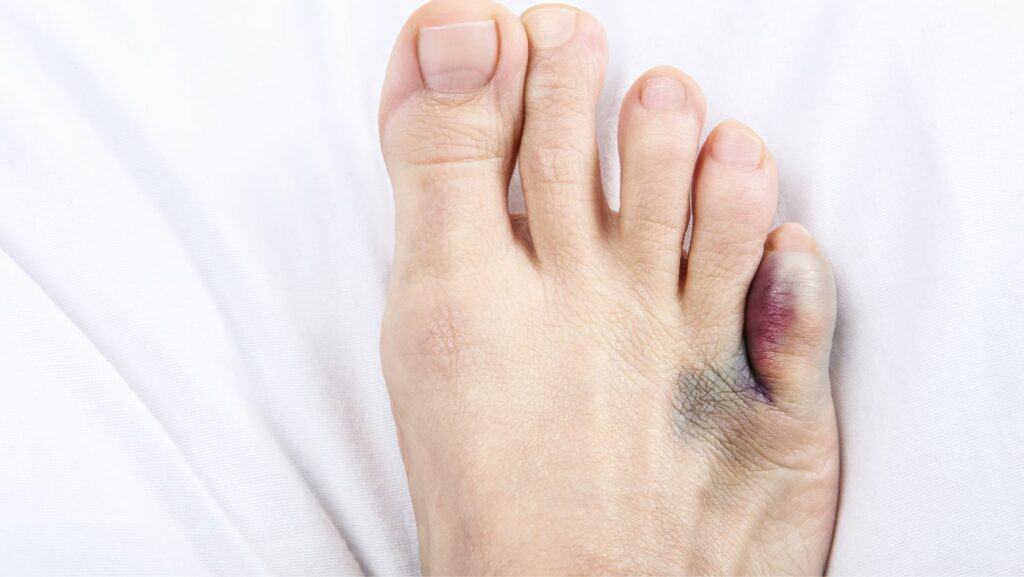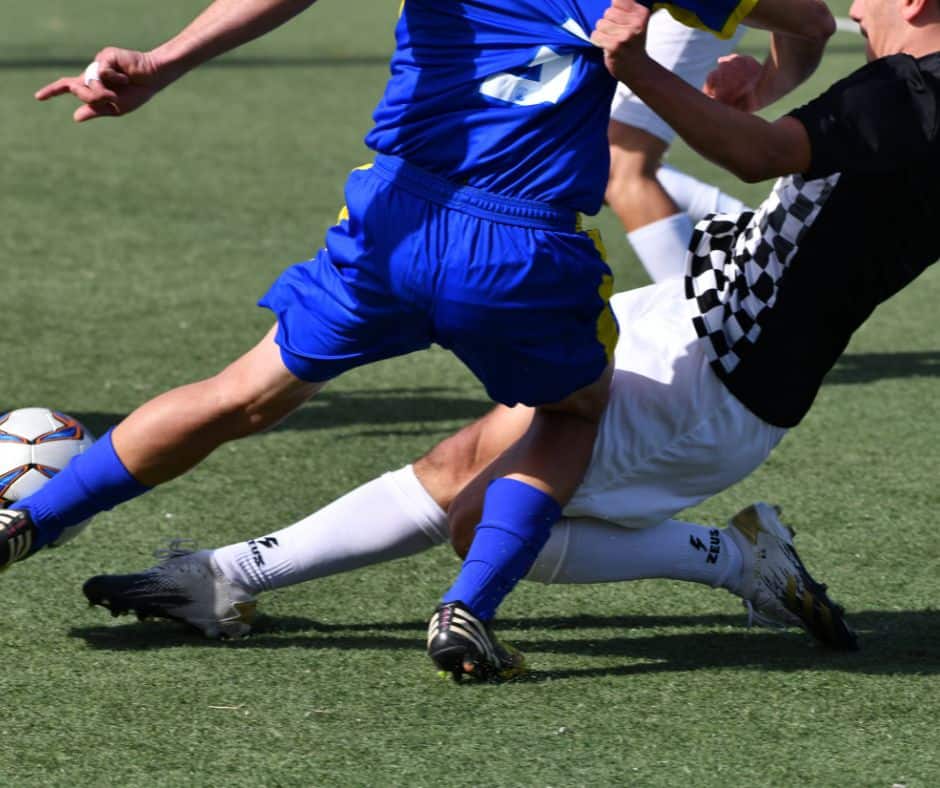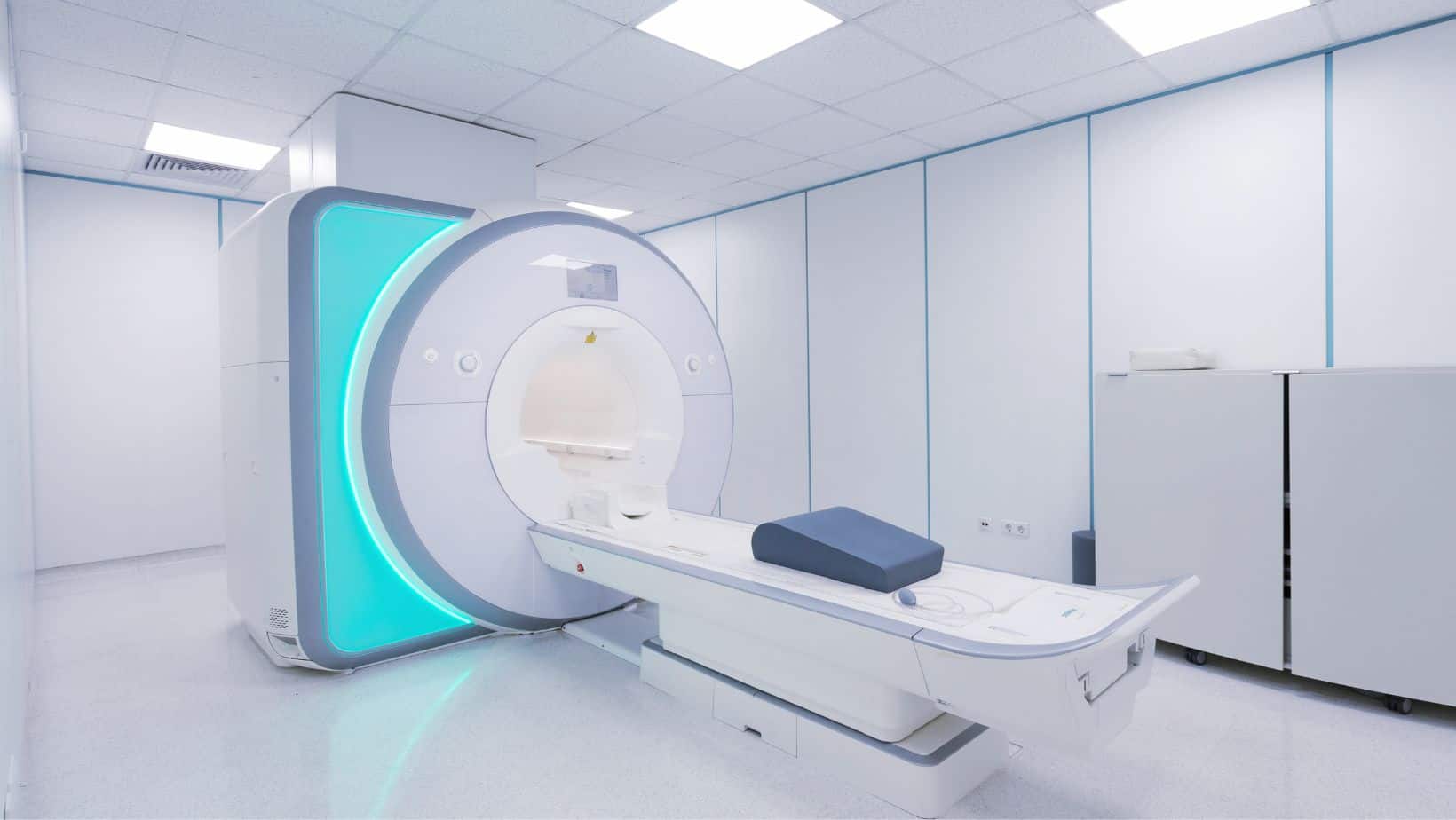Read More >
- Anterior Ankle Impingement - July 24, 2022
- Tarsal Coalition - October 12, 2022
- Sural Nerve Pain - October 3, 2022
Can you Sprain your Toe?
Yes, it is possible to sprain your toe. Ligaments are bands of tough, fibrous tissue that attach a bone to a bone. If a ligament becomes overstretched, it can lead to a tear in the ligament. When a ligament sprain occurs in the toes of the foot, it is known as a Sprained Toe. The most common of these is a sprained big toe (turf toe) or a sprained pinky toe (5th metatarsal)
A sprained toe can be separated into 3 grades:
Grade 1: A ligament is overstretched but not torn, which results in mild pain and swelling.
Grade 2: A partial tear of a ligament with moderate pain and swelling, while there may be a reduction in the range of motion of the joint.
Grade 3: A complete ligament tear, which is often associated with a ‘popping’ noise, alongside severe pain and swelling.

Sprained Toe Symptoms
A sprained toe can occur in any of the joints of the toes of the foot, but it is more common in the big toe (1st metatarsal) and little toes (5th metatarsal).
Symptoms of a Sprained Toe can vary depending on the severity and location of the sprain.
The most common symptoms of a sprained toe are:
- Pain around the joint of the toe
- Swelling of the joint but this can occur in the entire toe
- Bruising may be present 6-48 hours after the initial injury
- Stiffness of the joint from pain and swelling can result in a reduced range of movement
- It can be difficult to weight bear with severe sprains although this is a common sign of a fracture, especially in the 5th metatarsal.
Symptoms of a sprained toe are often worse when the toes are extended, walking, running or if direct pressure is applied to the affected ligament.

Causes of a Sprained Toe
The most common type of Sprained Toe is a Big Toe Sprain, also known as Turf Toe.
Turf Toe causes of most sprained toes are hyperextension of the joint when running on hard surfaces.
It is also common to sprain your toe when walking barefoot or flip-flops when it gets caught in an object. Hypermobility syndrome can increase your risk of a Sprained Pinky Toe..
How to Diagnose a Sprained Toe
A clinician, such as a Physical Therapist or a Podiatrist, can diagnose a Sprained Toe using clinical tests and a Physical examination. Tests to place the ligaments of the toe can identify a sprain as they are painful and have more significant laxity.
If the clinician wants to confirm the diagnosis or rule out other injuries, such as a broken toe, they may refer for an x-ray to rule out a fracture or an MRI to identify a ligament sprain.
Due to the superficial nature of Toe ligaments, ultrasound scans are an excellent modality for assessing the integrity of a sprained toe.

Sprained Toe Treatment
Home treatment for a sprained toe includes rest, ice and compression. The compression can help reduce the swelling, while ice is an analgesic. In moderate to severe cases, it can be helpful to immobilise the toe. You can support the affected toe by taping it to the nearest toe.
Physical Therapy is an effective treatment method involving taping, insoles, advice on footwear, stretches, stability and strengthening exercises.
Tape is highly effective at reducing pain levels by limiting the amount of extension of the joint, which is the primarily aggravating movement for a sprained toe. We have a dedicated article on how to tape a big toe sprain.
A Sprained Toe brace can also be used to limit the movement of the affected toe.
Insoles can bed as a medium to a long-term solution to reduce the amount placed on the affected joint, while stiff running shoes are a good alternative.
Stretching, stability and strengthening exercises can help to address any biomechanical causes of a sprained toe and are highly effective at injury reduction for athletes.
Once your pain has settled and your foot strength has improved, you can begin a return to sport programme under the guidance of your therapist.

FAQs
How Long Does a Sprained Toe Take to Heal?
Depending on the severity of a Sprained Toe, it can take 4-12 weeks to heel.
- A Grade 1 Sprained Toe takes approximately 2-4 weeks to heal.
- A Grade 2 Sprained Toe takes 4-8 weeks to heal.
- A Grade 3 Sprained Toe can take 12 weeks to heel and may require surgical intervention.
Sprained Big Toe vs Broken Big Toe
A Sprained Big Toe is a tear to the ligament in the big toe joint, whereas a Broken Toe is a fracture of the toe’s bone.
Nature of Injury:
A sprained big toe results from the overstretching of the big toe ligaments that results from catching your big toe on the corner of an object or repeated hyperextension of the joint from activities such as sprinting of a hard surface.
A big toe fracture is a break of the bone of the big toe, which can result from a heavy object falling on the toe, stubbing the big toe or a big toe stress fracture can occur from running.
Pain and Swelling
A sprained big toe can have swelling localised to the affected joint while a big toe fracture can have swelling of the entire toe while there may be pain on the bone or in the joint.
Diagnosis
Diagnosis of a sprained big toe can be achieved through an ultrasound scan or an MRI, while a big toe fracture requires an x-ray or an MRI.
What does a Sprained Toe look like?
A Sprained Toe is red and swollen immediately after injury, while within 24-48 hours, it is likely to become bruised around the joint and the toe itself.
Can you walk on a sprained toe?
Yes, you can continue to walk on a Sprained Toe. Limit your walks to 10-15 minutes, and wear stiff shoes alongside a sprained toe brace or taping to limit the irritation.
Can I run with a sprained toe?
In our experience, it is not recommended to run with a Sprained Toe, as it will likely worsen the symptoms and slow recovery. If you have a mild sprain and you have approval from your therapist to run, consider using a stiff-soled running shoe to reduce the stress placed on the affected joint.
Can you exercise with a Sprained Toe?
Yes, you can exercise with a Sprained Toe, and we recommend carrying out a non-impact activity such as swimming or cycling for cardiovascular exercise.
Physiotherapy with James McCormack
This is not medical advice, and we recommend a consultation with a medical professional such as James McCormack before trying any of these exercises. James offers Online Physiotherapy Appointments weekly.

